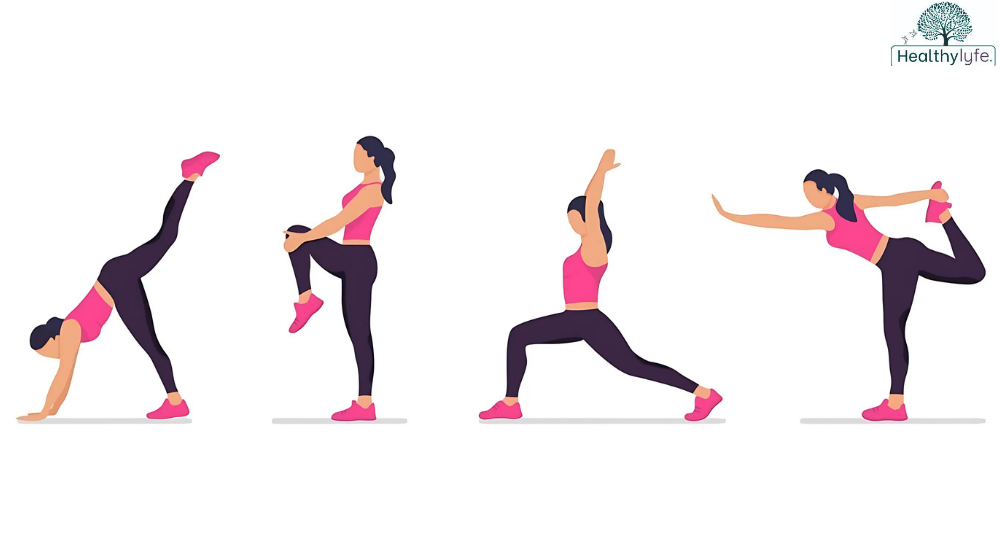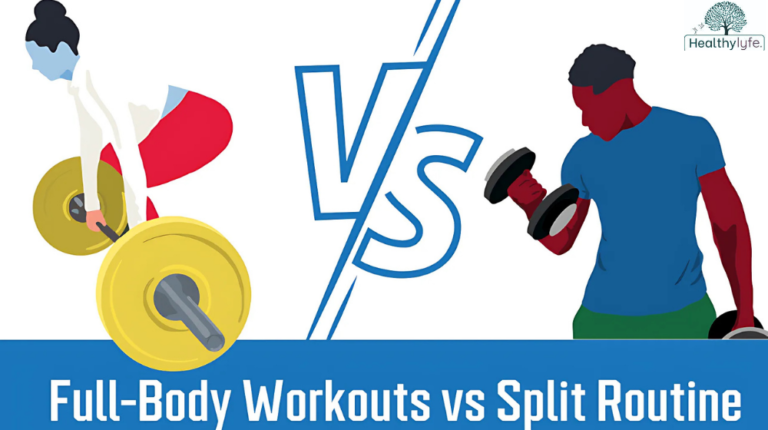Full-body workout vs. split workout Compare benefits to find the best fit for your fitness goals, from muscle building to fat loss.
Introduction
When it comes to working out, one of the biggest questions is: Should you do full-body workouts or split routines? Both are popular ways to train, but they work differently and are better suited for different goals and lifestyles.
A full-body workout hits all the major muscle groups in a single session. It’s usually done 2–4 times a week and is great for people who want a balanced approach, have limited time, or are just starting out. Split routines, on the other hand, focus on specific muscle groups during each workout (like chest and triceps one day, legs another day). These are often favored by those aiming to build serious muscle or target certain areas.
What Is a Full-Body Workout? [1]
A full-body workout is a type of exercise where you work all the major muscles in your body in one session. This includes your legs, back, chest, shoulders, arms, and core.
You typically do full-body workouts 2–4 times a week, with rest days in between to recover. These workouts often include moves like squats, push-ups, and rows that work several muscles at once, along with some exercises that target specific areas.
Full-body workouts are great if you’re short on time, new to working out, or just want a simple way to get stronger and more fit. They help you build muscle evenly, burn calories, and improve overall strength in a single session.
Examples of exercises in a full-body workout
Lower Body (Legs & Glutes)
- Squats – Great for building strength in your legs and glutes.
- Lunges – Targets quads, hamstrings, and glutes while improving balance.
- Deadlifts – Strengthens the back, glutes, and hamstrings.
Upper Body (Back, Chest, Shoulders, Arms)
- Push-Ups – Works your chest, shoulders, triceps, and core.
- Pull-Ups or Chin-Ups – Great for building back and bicep strength.
- Overhead Press – Targets shoulders and triceps.
Core (Abs & Stabilizers)
- Plank – Builds core strength and stability.
- Twists – Strengthens obliques and improves rotational strength.
Compound Movements (Whole Body)
- Burpees – A full-body exercise that combines cardio and strength.
- Kettlebell Swings – Works the hips, glutes, back, and shoulders while boosting cardio.
What Are Split Routines?
Split routines are workout plans where you divide your training sessions to focus on specific muscle groups or body parts on different days. Instead of working the entire body in one session, you “split” it up to target certain areas more intensely.
For example, a typical split routine might look like this:
- Day 1: Chest and triceps
- Day 2: Back and biceps
- Day 3: Legs
- Day 4: Shoulders and abs
This approach allows you to give each muscle group more focused attention and recovery time before you train it again. Split routines are popular among intermediate and advanced lifters, bodybuilders, or anyone looking to build muscle and strength in specific areas.
The main advantage of split routines is that you can include more exercises and volume (sets and reps) for each muscle group, which can help with muscle growth and targeting weak points. However, they often require more training days per week, so they’re best suited for people who can commit to a consistent schedule.
Examples of common splits
Upper/Lower Split
- Day 1: Upper body (chest, back, shoulders, arms)
- Day 2: Lower body (legs, glutes, core)
- Day 3: Rest or repeat
- Best for: Balanced strength and muscle growth, done 3–4 days a week.
Push/Pull/Legs Split (PPL)
- Day 1: Push (chest, shoulders, triceps)
- Day 2: Pull (back, biceps)
- Day 3: Legs (quads, hamstrings, glutes)
- Day 4: Rest or repeat
- Best for: Intermediate and advanced lifters wanting focused training, done 4–6 days a week.
Body Part Split (Bro Split)
- Day 1: Chest
- Day 2: Back
- Day 3: Shoulders
- Day 4: Arms (biceps and triceps)
- Day 5: Legs
- Best for: Bodybuilders or those focusing on high-volume training, done 5–6 days a week.
Full-Body/Rest Split
- Day 1: Full-body workout
- Day 2: Rest or active recovery
- Repeat: Every other day
- Best for: Busy individuals or beginners who prefer simplicity, done 3 days a week.
Upper/Lower + Push/Pull Hybrid
- Day 1: Upper body (heavy focus)
- Day 2: Lower body (heavy focus)
- Day 3: Push (lighter focus)
- Day 4: Pull (lighter focus)
- Day 5: Rest or repeat
- Best for: Advanced lifters seeking variety, done 4–5 days a week.
Benefits of Full-Body Workouts
Full-body workouts offer numerous benefits, making them an excellent choice for individuals of all fitness levels.

Efficient Use of Time
- Full-body workouts engage multiple muscle groups in a single session, reducing the need for multiple workout days.
- Ideal for busy individuals who want to maximize their workout time.
Balanced Muscle Development
- Ensures all major muscle groups are trained, reducing the risk of muscular imbalances.
- Promotes overall strength and functionality.
Increased Caloric Burn
- Activating multiple muscle groups simultaneously increases energy expenditure.
- Supports weight loss and fat burning.
Improved Cardiovascular Health
- Combines strength training with a cardiovascular component, especially when performed in a circuit or high-intensity format.
- Boosts heart health and endurance.
Flexibility in Scheduling
- Fewer sessions per week are required compared to split routines, making it easier to fit into a busy schedule.
- Can be done 2-3 times a week, allowing ample time for recovery.
Enhanced Functional Fitness
- Mimics real-life movements by engaging multiple joints and muscle groups.
- Improves coordination, balance, and overall functional strength.
Supports Recovery
- When performed with proper intensity and volume, full-body workouts can facilitate active recovery while maintaining fitness levels.
Beginner-Friendly
- Simple to design and execute, making it a great starting point for those new to fitness.
- Reduces complexity compared to split routines that target specific muscle groups.
Boosts Hormonal Response
- Stimulates the release of growth hormones and testosterone due to the large amount of muscle mass involved.
- Aids in muscle growth and recovery.
Variety and Adaptability
- Easily customizable to include bodyweight exercises, free weights, or machines.
- Suitable for all fitness levels, from beginners to advanced athletes.
Benefits of Split Routines
Focused Training for Muscle Groups
- Allows you to concentrate on specific muscle groups, enabling a more thorough workout for each.
- Ideal for targeting lagging muscles or achieving symmetry in physique.
Higher Training Volume
- Provides the opportunity to perform more sets and exercises per muscle group, enhancing hypertrophy (muscle growth).
- Helps advanced lifters push their limits with increased volume.
Optimal Recovery
- By focusing on different muscle groups on separate days, each group has more time to recover before being worked again.
- Reduces the risk of overtraining while maximizing muscle repair and growth.
Customizable and Goal-Oriented
- Can be tailored to specific goals, such as strength, size, or endurance.
- Examples include push/pull/legs, upper/lower splits, or body part splits (e.g., chest day, back day).
Better Mental Focus
- Narrowing the focus to one or two muscle groups per session can improve concentration and technique.
- Encourages intensity and precision in your workouts.
Reduced Workout Fatigue
- Working fewer muscle groups per session means you’re less likely to experience systemic fatigue.
- Helps maintain high energy levels throughout the workout.
Flexibility for Advanced Techniques
- Easier to incorporate advanced hypertrophy techniques like drop sets, supersets, and rest-pause sets for specific muscles.
- Supports detailed sculpting of particular muscle groups.
Encourages Consistency
- With a set schedule, split routines promote a habit of frequent training sessions.
- Ideal for gym-goers who enjoy regular, dedicated time at the gym.
Improved Strength Gains
- Facilitates progressive overload by allowing you to lift heavier weights for specific muscles without fatigue from training other groups in the same session.
- Enhances maximal strength development for individual lifts.
Great for Competitive Goals
- Perfect for bodybuilders, athletes, or those training for specific events or physique competitions.
- Provides time to refine and perfect form, symmetry, and muscle isolation.
Comparison of Split Routines vs. Full-Body Workouts
Both training approaches offer valuable benefits, making them suitable for different fitness levels and goals. Split routines are better for those focused on advanced strength and hypertrophy, while full-body workouts suit those seeking efficiency and overall balance.
| Aspect | Split Routine | Full-Body Workout |
|---|---|---|
| Frequency | 4-6 times per week | 2-3 times per week |
| Training Focus | Specific muscle groups | All major muscle groups |
| Volume | Higher volume per muscle group | Lower volume per muscle group |
| Recovery | Better recovery for specific muscle groups | Limited recovery per muscle group |
| Progression | Can accommodate progressive overload easily | Focused intensity on compound movements |
| Suitability | Experienced lifters, bodybuilders, athletes | Beginners, general fitness, balanced development |
Drawbacks of Full-Body Workouts:
Full-body workouts have gained popularity for their efficiency, but they come with some drawbacks:
- Lower Volume Per Muscle Group: Since the workout covers all major muscle groups in a single session, the volume per muscle group may be limited. This could hinder muscle growth and strength progression.
- Less Focused Training: With a full-body approach, there may be less opportunity for in-depth focus on specific muscles compared to split routines. This could affect advanced training goals, like hypertrophy (muscle building) or strength specialization.
- Fatigue Accumulation: Full-body workouts are intense, covering numerous exercises in a session, which can lead to higher overall fatigue and potentially slower recovery.
- Limited Frequency: Working all muscle groups in one session may require more time to recover between workouts, especially for those with high training intensity.
- Not Ideal for Advanced Lifters: Experienced lifters seeking advanced techniques like supersets or more specialized volume may find full-body workouts restrictive in meeting their goals.
Drawbacks of Split Routines
Split routines are commonly used in fitness and exercise programs, but they come with certain drawbacks:

- Time-Intensive: Split routines often require more time, as they focus on specific muscle groups, leading to longer training sessions.
- Muscle Imbalance: Focusing on individual muscle groups can lead to imbalances if not balanced properly. Overworking certain muscles while neglecting others may lead to structural issues or injuries.
- Overtraining: Intense split routines may lead to overtraining, especially if proper rest and recovery are not factored into the program.
- Limited Variety: Focusing solely on specific muscle groups can reduce the variety of movements, leading to a less comprehensive workout experience.
- Not Suitable for Beginners: Split routines often require a higher level of experience and knowledge about different muscle groups and exercises, which may be overwhelming for beginners.
Full-Body vs. Split: Effectiveness for Different Goals
Full-Body Workouts and Split Routines are two popular approaches to structuring exercise programs. Both have unique advantages and can be effective for different fitness goals. Here’s how they compare:
Full-Body Workouts
Effectiveness for Different Goals:
- General Fitness: Full-body workouts are great for improving overall fitness, as they work multiple muscle groups in a single session.
- Fat Loss: These routines are efficient in burning calories and promoting fat loss due to the high intensity of the workouts involving multiple muscle groups.
- Beginners: Full-body routines are often ideal for beginners because they provide a balanced approach to building foundational strength and improving overall movement patterns.
- Recovery: More recovery time is given to each muscle group, as they are worked less frequently than in split routines, reducing the risk of overtraining.
- Versatility: Suitable for a variety of fitness goals, including strength, endurance, and hypertrophy (muscle growth), when programmed appropriately.
Split Routines
Effectiveness for Different Goals:
- Muscle Growth (Hypertrophy): Split routines are highly effective for isolating specific muscle groups, allowing for focused intensity and greater volume per session, which is beneficial for muscle building.
- Advanced Training: Experienced lifters benefit from split routines as they can handle more volume per muscle group, helping achieve advanced strength and hypertrophy gains.
- Muscle Imbalances: Ideal for addressing specific weaknesses by dedicating sessions to certain muscle groups for improvement.
- Increased Training Frequency: Allows for more frequent training sessions, especially for muscle groups not fully recovered in a full-body workout.
- Not Suitable for Beginners: Split routines may be overwhelming for those new to fitness, as they require a solid understanding of different muscle groups and exercises.
Common Myths About Full-Body and Split Routines
There are a lot of misconceptions about full-body and split workouts. Let’s clear up some of the biggest myths:
Myths About Full-Body Workouts
- “Full-body workouts can’t build muscle.”
- Not true! Full-body routines can help you build muscle just as well as splits, especially if you’re consistent and push yourself.
- “They’re only for beginners.”
- Full-body workouts work for everyone, from beginners to advanced lifters. It’s all about how you set them up.
- “You can’t go heavy in a full-body workout.”
- Actually, full-body sessions often focus on big, heavy lifts like squats and deadlifts, which are perfect for building strength.
- “You don’t work muscles enough in one session.”
- While you may do fewer sets per muscle, you hit them more often during the week, which can be just as effective.
Myths About Split Routines
- “Split routines are only for bodybuilders.”
- No way! Splits work for anyone who wants to focus on specific muscle groups or improve weak areas.
- “You can’t lose fat with split routines.”
- Fat loss depends on your diet and overall activity, not the type of workout you do. Splits can burn calories too!
- “Splits are always better for muscle growth.”
- Both splits and full-body workouts can build muscle. It’s more about how much work you’re doing overall and how well you recover.
- “Splits take too much time.”
- They don’t have to. You can design shorter, focused split workouts to fit your schedule.
Expert Opinions and Recommendations
Fitness experts agree that both full-body and split routines have their place in workout programming. The key is choosing the right approach based on your goals, experience level, and lifestyle. Here’s what experts recommend:
When to Choose Full-Body Workouts

- Beginners:
Experts suggest full-body workouts for beginners because they are simple, build foundational strength, and help develop proper form. - Fat Loss and General Fitness:
Trainers often recommend full-body routines for those aiming to lose weight or improve overall fitness, as these workouts burn more calories by engaging multiple muscle groups. - Time Constraints:
If you can only work out 2–3 times a week, full-body workouts ensure all major muscles are worked each session, maximizing efficiency. - Recovery Needs:
Physical therapists and coaches highlight that full-body routines provide more recovery time between sessions for individual muscles, reducing the risk of overtraining.
When to Choose Split Routines
- Experienced Lifters:
Fitness professionals recommend split routines for those with experience in the gym who want to focus on building muscle size or addressing specific weak points. - Muscle Growth (Hypertrophy):
Experts agree that split routines allow higher volume and intensity for each muscle group, making them ideal for bodybuilders or those focused on hypertrophy. - Customization:
For athletes or individuals with specific goals, personal trainers often design split routines to target areas like strength, symmetry, or performance improvement. - Frequent Training:
If you train 5–6 times a week, split routines spread the workload, preventing burnout and letting you focus on one or two muscle groups per session.
General Recommendations
- Balance and Variety:
Many coaches suggest incorporating elements of both routines for long-term progress. For example, you could alternate between full-body and split programs every few months. - Consistency Over Method:
The consensus among fitness experts is that the best routine is the one you can stick to. Whether it’s full-body or splits, consistency and effort matter most. - Listen to Your Body:
Recovery and injury prevention are key. If a routine leaves you overly fatigued or sore, it may need adjustment.
Conclusion
Both full-body and split routines can be effective workout strategies, but their effectiveness depends on your individual goals, experience level, and lifestyle. Full-body workouts are ideal for beginners, those with limited time, or anyone focusing on general fitness, fat loss, or overall strength. They provide efficient, well-rounded sessions that target multiple muscle groups, making them a great choice for people with busy schedules or those looking to maximize calorie burn.
On the other hand, split routines are better suited for experienced lifters, individuals aiming to build muscle size, or those targeting specific areas for improvement. They allow for more focused, higher-volume training for each muscle group, making them a popular choice for bodybuilders and advanced athletes.
FAQs about Full-Body vs. Split Routines
What is a full-body workout?
A full-body workout targets all major muscle groups in a single training session.
What is a split routine?
A split routine divides workout sessions by focusing on specific muscle groups or body parts on different days.
Which approach is better for beginners?
Full-body workouts are often recommended for beginners due to their simplicity and emphasis on building foundational strength.
What’s the difference in frequency between full-body and split routines?
Full-body workouts are typically performed 2–4 times per week, while split routines may require 4–6 sessions per week.
Do both methods help build muscle?
Yes, both full-body and split routines can build muscle, but the choice depends on goals, experience, and schedule.
Which routine is better for fat loss?
Full-body workouts may be better for fat loss due to the higher calorie burn and overall intensity.
Which approach builds muscle faster?
For hypertrophy, split routines might offer more volume for individual muscle groups, potentially leading to faster growth for advanced lifters.
Can full-body workouts lead to overtraining?
Overtraining is unlikely with proper rest and recovery, but it depends on intensity and frequency.
Are split routines more effective for targeting weak points?
Yes, split routines allow you to dedicate more time and effort to specific muscles or areas of improvement.
Which is better for improving overall fitness?
Full-body workouts are generally better for improving overall strength, endurance, and functional fitness.
Which is better for people with limited time?
Full-body workouts are more time-efficient, as they require fewer sessions per week.
Can split routines work with a busy schedule?
Yes, but split routines often demand more commitment and consistent training days.
What’s the ideal session length for each?
Full-body sessions typically last 45–60 minutes, while split routines can vary from 30–90 minutes depending on focus.
Can full-body workouts fit into advanced training programs?
Yes, advanced lifters can use full-body workouts by increasing intensity, volume, or using periodization.
Which is easier to maintain long-term?
This depends on personal preference, but full-body workouts may be simpler to maintain for busy individuals.
How do recovery times differ?
Full-body workouts require at least one rest day between sessions, while split routines allow for shorter recovery times per muscle group.
Can full-body workouts include isolation exercises?
Yes, full-body workouts can incorporate isolation exercises, but they primarily focus on compound movements.
Do split routines increase the risk of imbalances?
If not carefully planned, split routines can lead to muscle imbalances due to overemphasis on certain body parts.
Which method is better for athletes?
Full-body workouts are often better for athletes because they mimic functional movement patterns and train the entire body.
Can I combine full-body and split routines?
Yes, many programs mix the two approaches, such as using full-body workouts during busy weeks and split routines during focused phases.
By healthylyfe


